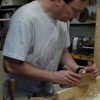After months of working on my new bench between necessary projects and work, I finally completed it. I just thought I'd post a few beauty and build shots since there are a few neanders out there considering DF and/ or bench styles. All the wood was bought at Home Depot since all sawmills and yards around here think hardwood is made of gold, so the total bill for the bench, including LV vise hardware, was about $120 as opposed to about $800 for 2-inch ash. The top is laminated DF 4x4s, except when I went for one culling trip and the HD had "white fir" labeled as DF. I didn't notice until I laid it up next to the redder DF, then I saw the ink stamp with the correct ID - the bar code label said DF. I put it in the back reaches of the top since it is softer. So, here goes:
bench01.JPGbench03.JPGbench04.JPGbench05.JPGbench07.JPGbench02.JPGbench06.JPGbench10.JPG
I jointed the boards for the top to remove the rounded corners on the top and side, leaving the bottom alone so I'd save every bit of thickness. I then routed grooves 2.5 inches from the top and installed 3/8 inch plywood splines. This helpd a lot during glue-up, keeping them all aligned while I clamped them. After final smoothing, the top is about 3 3/8 inches thick.
The base is made of two trestles, one with three legs and one with two. The feet have through-mortises, but the top support on the right (narrower) side has bridle joints since I wanted the stretcher to be flush with the top to act as the rail for the sliding board jack. The stretchers are through-mortised to the trestles with extra long tenons that are secured with 3/4-in. thick oak tusk tenons. I glued brackets to the stretchers at the tenons to give them more lateral strength - the result is a very stiff connection with no racking or wobble. the top is held to the trestles with one lag bolt on each side.
I don't want to get carried away writing about a fairly straighforward bench, but I'd be happy to answer any questions. I will add another message in this thread to describe the enclosed tail vise assembly and explain the dark stringing around the triple dovetail on the right end.
Karl





 Reply With Quote
Reply With Quote




